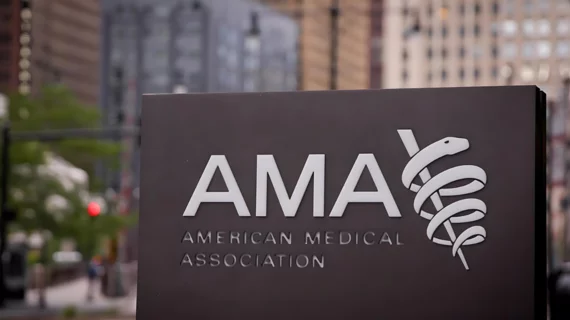AMA delegates voice concern about radiologists' exposure to ionizing radiation
The American Medical Association House of Delegates is expressing concern about radiologist and other physicians’ exposure to ionizing radiation.
Members of the HOD voted Tuesday to approve a resolution advocating for increased regulation to ensure healthcare workers are protected during imaging exams. The association cited several studies in the document, including a recent survey of 500 orthopedic residents. Conducted in 2018, the poll found that 98% of docs believe protective equipment should be provided during procedures, yet only 54% said their institution had done so.
“In addition to surgeons, specialists such as cardiologists and radiologists that rely on tools like fluoroscopy also have increased risk of cancer, with one prospective cohort study pointing to elevated risks of brain cancer, breast cancer and melanoma in radiologic technologists,” the resolution states.
Delegates approved the motion during the final day of the AMA’s Interim Meeting in Orlando, Florida, on Nov. 12. They want the nation’s largest physician lobbying group to encourage healthcare institutions to provide more comprehensive PPE coverage for different body types. This would include protecting employees of all genders and pregnancy statuses via aprons with capped sleeves, axillary supplements and maternity aprons.
Kristina Novick, MD, noted that regulations on radiation exposure vary by geography, with her specialty particularly concerned about this issue.
"As a radiation oncologist, I do not want to see my colleagues in my clinic with preventable cancers from their preventable exposure to radiation out of their selfless dedication to patient care," said Novick, who spoke on behalf of the American Society of Clinical Oncology, according to MedPage Today. “Radiation safety should be taken seriously by every specialty,” she added.
Ionizing radiation is a known carcinogen, and breast tissue is particularly sensitive to it, with a direct correlation between exposure and heightened cancer risk, the resolution notes. Standard aprons often leave the upper-outer quadrant of the breast and axilla exposed, increasing vulnerability. Other recent studies have indicated greater risk of breast cancer among female surgeons, and particularly those exposed to radiation during image-guided procedures. Female orthopedists have an upward of nearly fourfold increase in prevalence of breast cancer, compared with an age-matched female population.
The resolution also noted increasing popularity among women in fields that experience greater exposure to radiation, including orthopedic surgery.
During debate on Tuesday, multiple speakers said they believe this advocacy is “long overdue,” according to MedPage. They’re urging the AMA, American College of Radiology, American Association of Physicists in Medicine and others to “step up efforts” to research this issue. Delegates also amended the resolution to urge AMA to prepare a report for consideration during the next interim HOD meeting.

